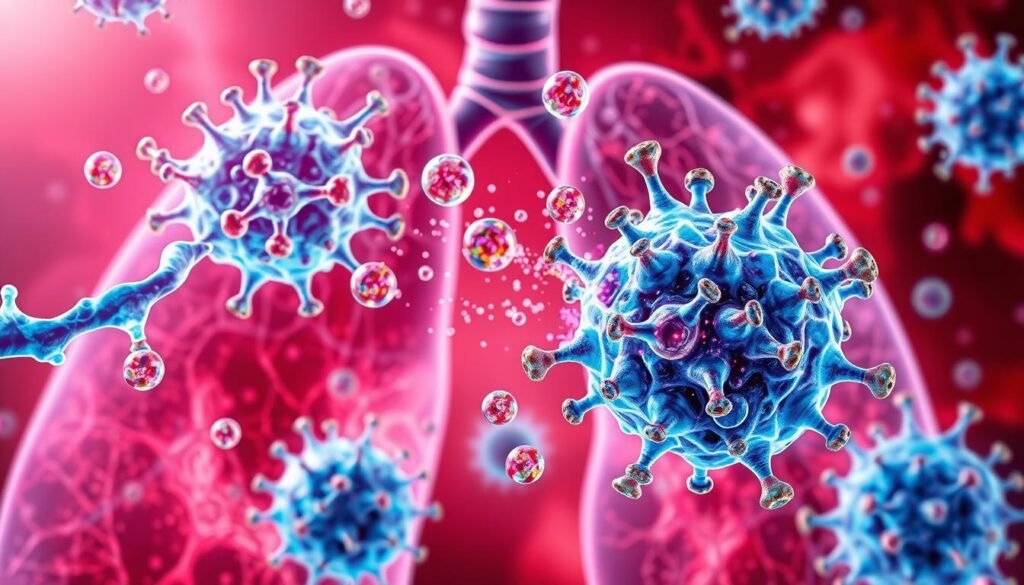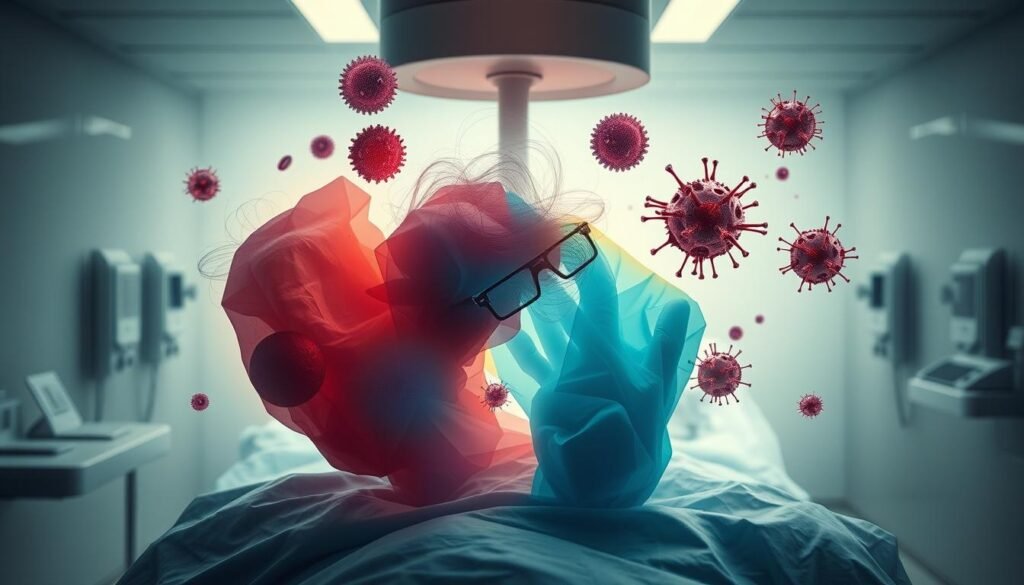Lung cancer is the top reason for cancer deaths, with over 150,000 lost each year in the U.S. alone. This fact shows the critical need for effective treatments like chemotherapy. Chemotherapy fights lung cancer by aiming at fast-growing cancer cells that harm the patient’s health.
Chemotherapy drugs, like Cisplatin and Docetaxel, are key in battling lung cancer. They work well in many treatment plans. Knowing how these drugs work helps patients understand their importance in lung cancer care. This knowledge brings hope and a clear path in the fight against lung cancer.
Key Takeaways
- Lung cancer is the leading cause of cancer-related deaths in the U.S.
- Chemotherapy is a pivotal treatment method for lung cancer.
- Cisplatin and Docetaxel are common chemotherapy drugs for lung cancer.
- Chemotherapy targets rapidly dividing cancer cells.
- Understanding chemotherapy mechanisms can empower patients.
Understanding Lung Cancer
Lung cancer is a major health issue that impacts many people yearly. It starts in the lungs, disturbing their function and can spread. Knowing about lung cancer is key for anyone looking into its treatment and care.
What is Lung Cancer?
Lung cancer begins when lung cells grow out of control. These bad cells can form tumors and make breathing hard. There are two main lung cancer types, based on what the cells look like. It’s important to know the type to choose the best treatment.
Types of Lung Cancer
- Small Cell Lung Cancer (SCLC): This is the rarer, more aggressive kind that spreads fast.
- Non-Small Cell Lung Cancer (NSCLC): This kind is more common, making up 80-85% of cases. NSCLC grows more slowly than SCLC.
Cancer Staging and Its Importance
Staging is key in treating lung cancer. It tells how far the cancer has spread, guiding treatment choices. The TNM system is often used to check the tumor size, lymph nodes, and if it has spread. Knowing the stage helps in planning treatment and predicting outcomes.
How Chemotherapy Attacks Lung Cancer
Chemotherapy is key in fighting lung cancer. It targets and kills cancer cells in different ways. Knowing how it works helps patients and doctors choose the best treatment plan.
Mechanisms of Chemotherapy
Chemotherapy stops cancer cells from dividing and surviving. Here are the main ways it does this:
- Disruption of Cell Division: Chemo drugs keep cancer cells from dividing. This slows down tumor growth.
- Promotion of Apoptosis: Many chemo drugs make cancer cells self-destruct. This removes them from the body.
- Targeting Rapidly Dividing Cells: These drugs hit cancer cells hard because they divide so fast.
Common Chemotherapy Drugs for Lung Cancer
Here are some top chemo drugs for lung cancer:
- Paclitaxel: It stops cancer cells from dividing by freezing them at a specific stage.
- Gemcitabine: Used with other drugs, it blocks DNA making, which cancer cells need to grow.
- Cisplatin: A platinum drug that damages cancer cell DNA, causing death.
- Carboplatin: Like Cisplatin, but often easier on patients due to different side effects.
In summary, knowing how chemotherapy works and the drugs often used for lung cancer is crucial. It shows how chemo fights lung cancer effectively, giving hope to those being treated.
The Role of Chemotherapy in Lung Cancer Treatment
Chemotherapy is key in treating lung cancer. It’s designed around each patient’s unique needs. Choosing the right chemotherapy involves looking at cancer’s stage, its type, and the patient’s health. This way, the treatment works well against cancer and has fewer side effects.
Choosing Chemotherapy for Treatment
Choosing the right chemotherapy depends on the type of lung cancer and how far it has spread. Chemotherapy is important for shrinking tumors, better survival rates, and easing symptoms. Different drugs work better on different cancers. Knowing the options helps patients decide on their treatment.
Combining Chemotherapy with Other Treatments
Chemotherapy, surgery, and radiation are often used together. This mix can give better results than chemotherapy alone. For instance, chemotherapy before surgery can make removing the tumor easier. For more about lung cancer treatments, check out this detailed guide.

| Chemotherapy Treatment Strategy | Benefits | Considerations |
|---|---|---|
| Neoadjuvant Chemotherapy | Can shrink tumors before surgery | May not be suitable for all patients |
| Adjuvant Chemotherapy | Kills remaining cancer cells post-surgery | Risk of recurrence still present |
| Combination Chemotherapy | Targets multiple cancer mechanisms | Potential for increased side effects |
| Maintenance Chemotherapy | Helps prevent cancer recurrence | Continued monitoring required |
Side Effects of Chemotherapy
Chemotherapy is key in fighting lung cancer, but it comes with side effects. Knowing these side effects helps patients prepare and ease discomfort. During therapy, patients might face common symptoms.
Common Side Effects Experienced
Many people going through chemotherapy face several side effects, impacting their daily life. Frequently seen side effects are:
- Nausea and vomiting
- Hair loss
- Fatigue
- Increased risk of infection
These happen because the treatment affects both cancerous and healthy cells. This often interrupts normal body functions. Knowing about these effects allows people to get ready and take action during their treatment.
Managing Chemotherapy Side Effects
Managing side effects well can make life better. There are many ways to handle chemotherapy symptoms. Some useful methods include:
- Using anti-nausea medicine from your doctor.
- Eating a balanced diet with all the nutrients you need.
- Trying relaxation techniques to lessen stress and fatigue.
- Drinking plenty of water to stay healthy.
Getting support from health experts is key. They create personalized plans for you. For more tips on handling side effects, Moffitt Cancer Center has good information.

| Side Effect | Description | Management Strategy |
|---|---|---|
| Nausea | Feeling sick to the stomach, often leading to vomiting. | Anti-nausea medications and light meals. |
| Hair Loss | Thinning of hair or complete hair loss. | Wigs or scarves can provide comfort and style. |
| Fatigue | Extreme tiredness affecting daily activities. | Rest periods and gentle physical activity. |
| Infection Risk | Increased susceptibility to infections due to weakened immunity. | Good hygiene practices and avoiding crowds. |
Using these strategies, patients can feel better during chemotherapy. They effectively tackle side effects with comfort and ease.
Cancer Prognosis and Remission
The journey through lung cancer brings a deeper understanding of prognosis and remission. Prognosis is the expected outcome based on factors at diagnosis time. It helps patients decide on their treatment plans. Lung cancer prognosis varies greatly. It depends on the stage at diagnosis, patient health, and tumor response to treatments.
Understanding Prognosis with Lung Cancer
Lung cancer prognosis isn’t set in stone. Survival rates change based on cancer type and stage. Early-stage patients usually have better outcomes. For localized lung cancer, five-year survival rates are much higher. To see specific survival stats, visit this resource.
Factors Influencing Cancer Remission
Cancer remission means a decrease in cancer signs and symptoms. It leads to significant patient improvement. Several factors are crucial for achieving and keeping remission. These include:
- Stage of cancer at initial diagnosis
- Response to chemotherapy or other treatments
- Patient’s lifestyle and overall health, including fitness and nutrition
- Genetic markers and mutations influencing treatment outcomes
Knowing these influences helps patients in their treatment journey. It motivates a proactive approach towards remission.

Targeted Therapy for Lung Cancer
Targeted therapy marks a big change in treating lung cancer. It doesn’t harm cells like chemotherapy does. Instead, it goes after the cancer cells’ specific changes. This method tries to keep healthy cells safe while fighting lung cancer.
What is Targeted Therapy?
Targeted therapy uses drugs aimed at cancer cells’ specific genes and changes. In lung cancer, especially non-small cell type, there are many mutations like EGFR and ALK. Drugs such as Erlotinib and Alectinib show how this method works, offering a more focused treatment than chemotherapy.
Advantages of Targeted Therapy Over Traditional Chemotherapy
The plus sides of targeted therapy stand out. Mainly, it causes fewer side effects than old-school chemo does. This means patients deal with less nausea, hair loss, and tiredness. That makes their day-to-day better. Also, these therapies hit cancer growth directly, making treatments work better.
- Minimized impact on healthy cells
- Reduced side effects
- Increased focus on specific genetic mutations
New targeted therapy options keep showing up, proving their value in lung cancer care. As doctors get more into this focused way, patients get treatments that really fit their needs.
Immunotherapy and Its Benefits
Immunotherapy is a powerful way to fight cancer, using our own immune system. It turns our body into a fighter against cancer cells. People are talking about treatments like Pembrolizumab, especially for lung cancer.
Understanding Immunotherapy
Immunotherapy tackles lung cancer in a special way. It boosts our immune system to destroy cancer. This approach could lead to longer lives and less side effects. This means patients can enjoy life more during treatment. Knowing the causes of cancer helps make immunotherapy more effective. Check out more about cancer risks here.
Comparing Immunotherapy to Chemotherapy
When we talk about fighting lung cancer, immunotherapy versus chemotherapy is a hot topic. Chemotherapy shrinks tumors but has tough side effects like nausea. On the other hand, immunotherapy works differently, with its own side effects. This comparison helps patients and doctors make better treatment decisions. Ongoing research is making lung cancer treatments better all the time.
| Feature | Chemotherapy | Immunotherapy |
|---|---|---|
| Mechanism of Action | Targets rapidly dividing cells | Activates the immune system |
| Common Side Effects | Nausea, hair loss | Immune reactions, fatigue |
| Treatment Duration | Specific cycles, often several months | May vary based on response |
| Quality of Life | Can be affected significantly | Often maintained better |
| Patient Response | Varies widely | Promising results in specific populations |
Combination Treatments in Lung Cancer
Lung cancer treatment often uses different methods together. Adding radiation therapy to chemotherapy can make treatments work better. This helps patients understand how these treatments help each other.
Radiation Therapy alongside Chemotherapy
Radiation therapy and chemotherapy are combined for better results in treating lung cancer. This combination targets cancer cells more effectively. It’s especially useful in several situations:
- Eliminating remaining cancer cells after surgery
- Reducing the size of tumors before surgical procedures
- Palliation of symptoms in advanced stages of lung cancer
Benefits of a Multi-Modal Approach
Using multiple treatments offers many benefits. Research shows it can lead to longer survival for patients. Key advantages include:
| Advantage | Impact |
|---|---|
| Increased Efficacy | Greater tumor reduction and improved response rates |
| Reduced Recurrence | Lower chances of cancer returning post-treatment |
| Symptom Management | Enhanced quality of life through better symptom control |
Conclusion
The journey to treat lung cancer involves knowing many therapies, with chemotherapy being really important. Chemotherapy attacks lung cancer cells in advanced ways. It’s key in treatment plans, giving patients better options for their future.
This approach includes targeted therapy and immunotherapy. It makes a strong plan to fight this tough disease.
Lung cancer treatment is always changing, meaning personalized care is crucial. People with lung cancer work closely with their doctors. This helps them understand their treatments better and choose wisely.
Learning about chemotherapy and new treatments helps patients be part of their care. This increases their chance of getting better.
Looking into how important chemotherapy is shows its role in battling lung cancer. As new discoveries are made, it’s important for patients and families to be up-to-date. This way, they get care that fits their health needs perfectly.